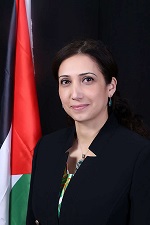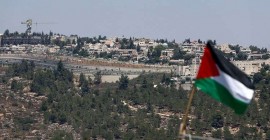Education in COVID-19: From disruption to recovery
Palestine Economy Portal
Most countries around the world have temporarily closed schools and universities as part of the lockdowns in an attempt to contain the spread of the COVID-19 pandemic. These worldwide closures are impacting hundreds of millions of students.
This disruption in education due to COVID-19 is historically unprecedented. Schools have closed in at least 147 countries, affecting more than 1.4 billion children and youth, comprising around 86 percent of the world’s student population.1
Palestine is a young society where 45.3% of the population is under the age of 18. Thus, the impact of any phenomena on this large segment will entail effects on the whole society, as is the case with the high unemployment rates and the deteriorating socio-economic conditions due to the pandemic. Around 1.3 million students had to stop going to school during the lockdown in March 2020 and return has been limited and inconsistent, mostly as a hybrid between physical presence and distance learning. The educational process has changed completely with the procedures taken to prevent the spread of the virus. For example, governmental schools started their new year with classes open for grades one through four, to be followed two weeks later by grades five through eleven, taking into account that groups of students attend classes on some days of the week while receiving distance education from home during the rest of the weekdays. A decision was also made to include only 22 students in each classroom, while normally government and UNRWA school classrooms accommodated up to 50 students.
The majority of the population in Palestine own smart phones which was at a rate of around 84% at the end of 2017. However, only 43% of households have a computer (desktop or laptop) and only 52% of households in Palestine have internet access at home. These figures reflect the readiness of the available infrastructure and that required for acquiring the basis for a distance learning operation. This crisis is unprecedented in Palestine except during the first Intifada back in 1988 when schools were shut down for a period of three months. However, the impacts of COVID-19 are expected to be more prolonged and will involve different aspects such as health recommendations related to social distancing, hand washing, and avoiding touching the face.
The effects of these closures have been disproportionate on education systems; there are three types of schools: government-run schools, private schools, and schools operated by the United Nations Relief and Works Agency for Palestine Refugees (UNRWA). Private schools were the best equipped to handle distance learning, whereas available infrastructure was still far from ready to handle this huge crisis.
The Palestinian Government and the educational sector, like many others, have been looking for ways to overcome the challenges of distance learning in terms of access, channels, strategies, and infrastructures. However, this has been challenging due to the fluctuating numbers of cases each month, the already fragile socio-economic conditions, and the political and financial crises. In times of great uncertainties, the roles of data and statistics become more vital than ever.
How vital are statistics in times of crises?
Palestinian Central Bureau of Statistics (PCBS) realized the importance of carrying out a rapid assessment to capture the new situation created by the pandemic. We conducted a special survey to measure the effects of COVID-19 on the socio-economic conditions of Palestinian households during the pandemic. The sample included 2,368 households in which we had 1,964 fully completed questionnaires. This sample was selected from the Socio- Economic and Food Security (SEFSEC) of 2018 database for a couple of reasons including the ability to make comparisons between the pre COVID-19 and the post COVID-19 eras since the two surveys cover almost the same issues. The SEFSEC database also included telephone numbers of all households, thus making it easier to carry out data collection through Computer Assisted Telephone Interviewing (CATI).
The shocking results reveal that only 51% of households with children in schools participated in online education despite all of those children being enrolled in regular education before the lockdown. When digging further into the causes, we found that 49% of households mentioned that the unavailability of internet within the household prevented their children from participating in the online educational activities during the lockdown period, while 22% of those children did not participate due to the fact that their teachers did not perform/conduct any educational activities, and 13% did not participate as a result of the children themselves refusing to carry out or perform educational activities.
The survey revealed an interesting split in opinion about online education among those households with children who participated in online education during the lockdown: 40% of households evaluated online education as a bad experience which failed to fulfill its desired task, while 39% of evaluated it as being good and successful in fulfilling its desired task, with room for enhancement, and 21% evaluated the experience as being good and successful in fulfilling the desired task. Taking these figures into consideration, it is clear that this is an alarming situation with regard to access to education and the quality of education provided.
A second round is currently in preparation to include additional households to replace ones who did not respond (12.3%) from the same main database. This will help us compare responses with the first round based on the developments of the pandemic, where some modifications were made to the questionnaire to reflect these updates including vaccines.
The path to recovery
It was clear to everyone that we needed to change our ways of thinking and operating, even though massive efforts were implemented in a very short period of time. Under the shock of these changes in the national and the global systems, it is essential to create ways for new approaches to rehabilitate the social and educational process.
To demolish the poor effects on quality and be ready for future shocks, governments need to be innovative more than ever, think out of the box, and learn to customize best practices to fit our own case. Urgent action is required to prevent a learning crisis from becoming a global generational catastrophe. In Palestine, we historically have believed in the power of education; we still use education as a shield especially for young girls and those with no other options to improve their lives.
Distance learning cannot replace face-to-face interaction with teachers. I believe that in light of the complexities of this stage, the value and role of teachers in raising future generations increases. Teaching is one of the most humane professions and teachers everywhere should be a top priority in protection programs, including COVID-19 vaccinations. Teachers should be provided with more incentives, more attractive working environments, and options for a more rewarding career.
A deep analysis and revision of educational systems is needed to cope with this new era, including financing and cooperating to mobilize different resources, investing in information technology and digitization, and capacity development. Education and learning is a primary driver of progress across all 17 Sustainable Development Goals as a pillar of just, equal, and inclusive peaceful societies. Peaceful, prosperous, and productive societies cannot be achieved without effective educational systems.
1 United Nations Development Programme (UNDP). COVID-19 and human development: Assessing the crisis, envisioning the recovery. 2020 Human Development Perspectives, 2020, New York: UNDP, available at http://hdr.undp.org/en/hdp-covid.

